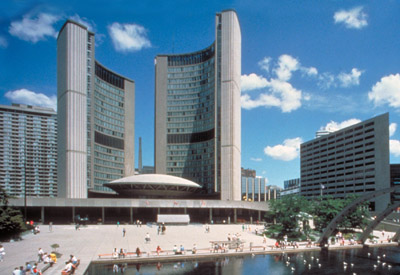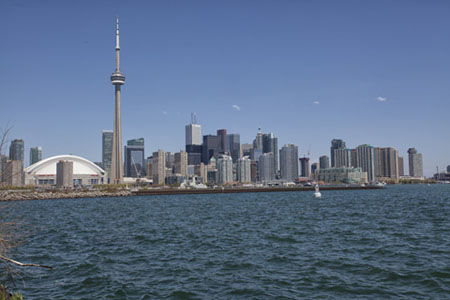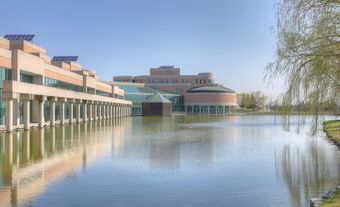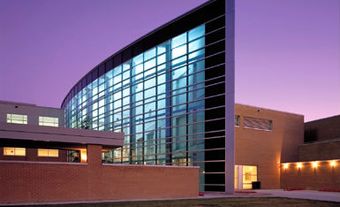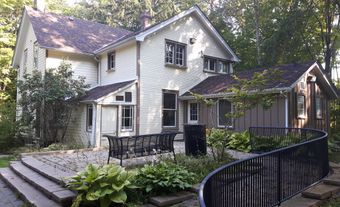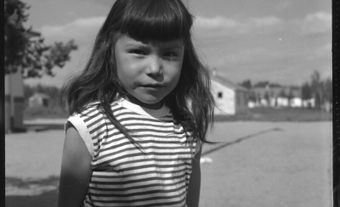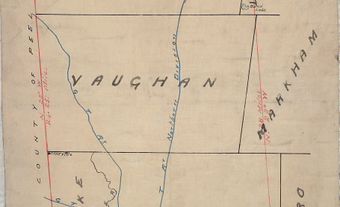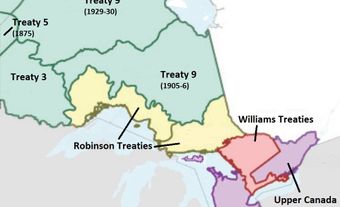Indigenous Peoples
Approximately 12,500 years ago the Laurentide Ice Sheet, a continental glacier that covered northeastern North America, retreated from the area of present-day Toronto. Soon afterward small groups of Indigenous peoples moved into the area to hunt animals such as caribou. Around 5,000 years ago, settlements in hunting territories began to form, and people congregated in large spring or summer gatherings at the mouths of rivers to fish, trade and bury their dead. By 500 CE, the population of Southern Ontario had reached 10,000, and was made up mostly of Algonquian-speaking peoples.
The introduction of maize (or corn) 1,400 years ago led to the adoption of farming and permanent settlement. By 1000 CE Iroquoian-speaking peoples had moved into the region of present-day Toronto, and by 1300 they had established villages there. By 1400, Iroquoian peoples lived in fortified villages that typically included longhouses and stockades that overlooked fields of crops.
For a variety of reasons, including better soil and warfare with the Haudenosaunee of New York State, Iroquoians in the Toronto area began to slowly move north to join the Huron-Wendat Confederacy in Huronia. In 1650, inter-tribal warfare and the diseases brought by Europeans led to the collapse and dispersal of the Wendat Confederacy. The Haudenosaunee established a series of settlements in Ontario, including two Seneca villages in present-day Toronto.
Around this time, Algonquian speakers began to move south from the Canadian Shield into the Toronto area. Through a process of negotiation, the Algonquian-speaking Anishinaabe entered into an alliance with the Haudenosaunee. The Anishinaabe established settlements in the Toronto area, while the Haudenosaunee withdrew to New York State. Some members of the Anishinaabe became known as the Mississauga, and dominated the area until the end of the 1700s.
The name Toronto is derived from the Mohawk word tkaronto, which means “where there are trees standing in the water.” (See also Largest Cities in Canada With an Indigenous Name.) The word originally referred to The Narrows, near present-day Orillia, where the Wendat and other groups drove stakes into the water to create fish weirs. French maps from the 1680s to 1760s identify present-day Lake Simcoe as Lac de Taronto. The spelling changed to Toronto during the 18th century, and the term gradually came to refer to a large region that included the location of the present-day City of Toronto. As of 2016, Indigenous peoples make up 0.9 per cent of Toronto’s population.
Settlement
At some point between 7,000 and 2,000 years ago, Indigenous peoples discovered an overland shortcut between Lake Ontario and Georgian Bay. Later known as the “Toronto Passage,” this trail was an important north-south route for both Indigenous peoples and Europeans.
French fur traders had known about the Toronto Passage since the early 1600s, and in 1720 they built a small store on the Humber River. This post failed financially and was abandoned in 1730. In 1750, the French built another small trading post called Fort Rouillé (or Fort Toronto), located in Toronto’s present-day Exhibition Grounds. It was burned in 1759 by its French garrison during a retreat from British forces.
Following the British Conquest in 1759, the Toronto site saw minor traders and Mississauga encampments. The American Revolution, however, sent Loyalists northward to remaining British territory. Their settlements along the upper St. Lawrence and lower lakes led to the creation of the province of Upper Canada in 1791 (see also Politics in Ontario). The province’s first governor, John Graves Simcoe, planned a centrally located town at Toronto. Simcoe saw the site as a commanding position for a naval and garrison base to guard a troubled American boundary. In 1793, he had a little town laid out by the harbour, which he named York, in honour of the Duke of York, son of King George III. Soon he was using York as a capital of Upper Canada, erecting parliament buildings and cutting roads inland. In 1796, Yonge Street, named by Simcoe for then-British Secretary of State for War Sir George Yonge, was opened. The street had its origins in the Toronto Passage, and like the original trail, it ran northward to the Holland River, giving access to Lake Simcoe and on to Georgian Bay.
York's officialdom and garrison attracted merchants, craftsmen and labourers, while the spreading rural settlement beyond made it a local market centre. By 1812, this frontier village still had only 700 residents, yet its governing role, its harbour and its rough roads to the interior of Upper Canada gave it an initial economic advantage in the Lake Ontario area.
Treaties
By the mid-1830s, the colonial government had made treaties with Indigenous peoples for the surrender of their territories, covering most of the arable lands in Upper Canada. One of these treaties was the Toronto Purchase (also known as Treaty 13). First drawn up in 1787, a revision of the agreement was made in 1805 between local First Nations and colonial authorities. The Purchase covers much of present-day Toronto, from Lake Ontario to the city’s western and northern limits. Toronto’s eastern portion is covered by one of the Williams Treaties, signed in 1923. (See also Upper Canada Land Surrenders; Reserves in Ontario.)
Development
During the War of 1812 York was twice raided and pillaged by US forces (1813), leaving a British-minded populace with keen anti-American memories. After the war, the village was one recipient of the rising wave of British immigration to Upper Canada. By pursuing trade with expanding farming frontiers, York became the province’s banking centre. By 1834, the fast-growing town of over 9,000 inhabitants was incorporated as the city of Toronto, with an elected civic government led by the city’s first mayor, William Lyon Mackenzie. This prominent Reform journalist and politician tried to seize the city by force in the Upper Canada Rebellions of 1837, but his attempt collapsed (more from confusion than bloodshed) and strengthened Toronto's conservative tendencies.
In the 1840s, Toronto increased its commercial lead. Gas lighting and sewers on main streets and steamboat port activity marked its urban rise. In the 1850s, railway building connected Toronto to New York and Montreal, the upper lakes at Georgian Bay, and across western Upper Canada to Detroit and Chicago. Toronto was made capital of the new province of Ontario at Confederation in 1867, and by the 1870s it was becoming markedly industrialized. The city’s population grew by five times between 1831 and 1891. In the 1880s Hart Massey's agricultural machinery firm, clothing factories, publishing plants and metal foundries grew substantially. The city’s growth was aided by industrial tariff protection after 1879 and the promotional drive of leaders such as railway builder Casimir Gzowski and department store builder Timothy Eaton.
The settlement of the Canadian West and the tapping of Northern Ontario's forests and mines, in the 1890s and 1900s, opened further markets and resources to Toronto. Commerce with the North and West flowed into the city, which in turn dealt with either Montreal or New York as outlets or as suppliers. Major firms such as Eaton's spread their mail-order business into the West. Hydroelectric power from Niagara Falls (1911), produced by the Hydro-Electric Power Commission of Ontario, provided cheap energy that spurred more factory growth. The influence of the city's banks, investment and insurance companies spread to regions well beyond Ontario.
By 1914, although the older and larger Montreal still held the lead, Toronto's financial head offices, factories and stores had made it a second national metropolis. The First World War expanded its investment and manufacturing scope. Manufacturing ranged from large-scale meat processing to munitions; both industries were forwarded by businessman Sir Joseph Flavelle.
In the prosperous 1920s, development continued as new suburban municipalities rose around an overflowing city of approximately half a million people. This growth was checked by the Great Depression of the 1930s. Gold and silver mining in Northern Ontario helped some financial sectors stay in above-average health, but overall the city was hard-hit as construction slowed considerably and unemployment skyrocketed. Although the employment rate slowly began to improve in 1934, high unemployment was only ended by the coming of the Second World War. The war revived growth, shaping electronic, aircraft and precision-machine industries. In the postwar era Toronto’s economy boomed, fuelled by consumer spending, the baby boom, house construction and the Korean War of 1950–53. The city’s population swelled further, to over a million in Greater Toronto, by 1951.
The service needs of this urban complex and its suburbs led to a metropolitan government. Set up in 1953, under a vigorous first chairman, Frederick Gardiner, the Metropolitan Toronto Authority handled area-wide requirements while the old jurisdictions attended to local concerns. The subway system, (begun by the city in 1949) was built up, parks and drainage projects were undertaken and arterial roads were constructed. In 1967, small suburbs were amalgamated, leaving a Metro structure of the city of Toronto and five boroughs, of which all but East York had become cities by 1991.
All lost their individual municipal structures in 1998 when the new "megacity" of Toronto came into existence. Toronto eventually gained priority over Montreal as a national (and international) financial hub. It also now leads Canada in its concentration of specialized services, including professional facilities and advertising, and it has a major hold on information media.
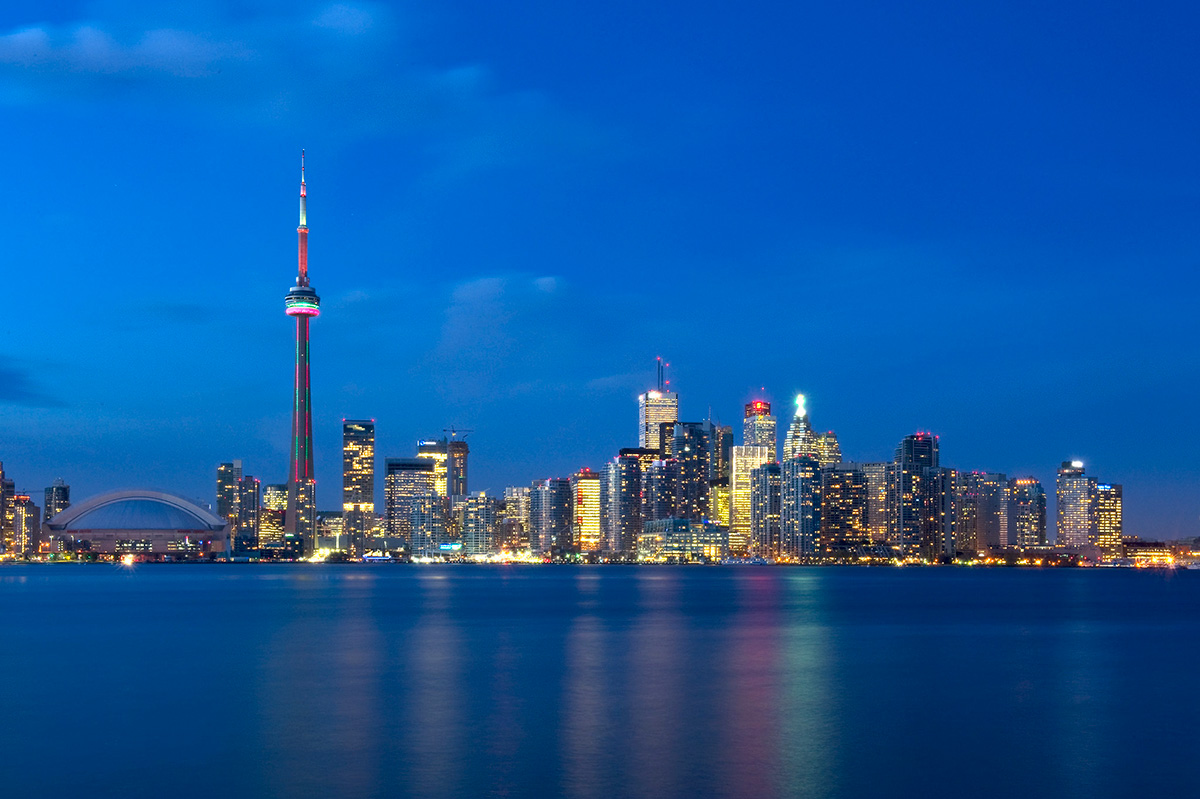
Cityscape
Toronto is located on the shore plain beside its harbour. There is a fairly abrupt rise 4 km inland which marks the shoreline of Lake Iroquois, formed by glaciers 12,500 years ago, that had a much higher water level than Lake Ontario. This rise led to higher plains, then to rounded lines of hills. Though the low-lying waterside area gave early York dank marshes and mud-filled streets, and though the rise behind impeded road lines, these were not long-term barriers to the steady spread of the cityscape. Today, Toronto extends far east and west of the harbour and far inland.
The shore plain by the harbour has remained Toronto's downtown core. Governor Simcoe's 1793 layout was a small-town plot with a plain grid of straight streets along the eastern end of the harbour, with a military reserve for a garrison post at the settlement’s westward entry. As the town grew, the basic straight-line grid pattern was essentially extended; however, under municipal self-government from 1834, planning was replaced by uncoordinated private developments.
Nevertheless, the cityscape began to take shape. By the 1840s, King Street was a main commercial east-west artery, and Yonge Street was a north-south axis, leading to the northern highway and to the interior of the province (see also Iconic Streets in Canada). As railways arrived on the waterfront in the 1850s, they built up a transport zone between the city and the lake. Thereafter, industrial areas emerged at either end of the harbour along rail lines. To the north, close-built, working-class districts arose. Larger residences spread above the central downtown, and the homes of the wealthy were on the rise behind the shore plain.
Horse-drawn cars in the 1860s and electric cars in the 1890s encouraged a middle-class movement to roomier suburban fringes, beginning with Yorkville (1883) and ending with North Toronto (1912). Beginning in the 1880s, electric elevators, larger iron-framed buildings and telephones facilitated greater business concentration on expensive downtown property. During the early 1900s, steel skyscrapers climbed in this central district, where economic land use was roughly divided into wholesaling around Yonge Street below King Street, major retailing along Yonge near Queen Street and finance down Bay Street and along King.
Aided by the automobile, the massing inward and spreading outward continued after the First World War until the Great Depression and the Second World War intervened. Public planning revived in the 1940s, and since the late 1940s the city’s growth has surged on, with only short downturns. Public planning’s impact grew beginning in the 1950s with the Metro structure, and grew further with the onset of environmental reformers (or conservers) in the 1960s and 1970s. The balance between the "move traffic" and "save life quality" kinds of planning remains a shifting one. The high-rise now dominates Toronto and can be found in the central business district, in residential apartment masses and in office towers around main intersections and subway stations.
Despite its modest natural setting and largely plain street layout, Toronto has an interesting building stock and some noteworthy heritage structures. These include the original Fort York complex (rebuilt 1813–15); the Grange, a gentry mansion built about 1817; St Lawrence Hall (1850), originally a public building containing a hall and shops; Osgoode Hall (rebuilt 1857–60), headquarters of the Law Society of Upper Canada; University College (1859), at the University of Toronto’s main campus; the Ontario Parliament Buildings (1892); Old City Hall (1899); the Royal Alexandra Theatre (1907) and Union Station (opened 1927), a prime North American survivor of classical railway grandeur.
Later eras have largely produced more and bigger office buildings, hotels and shopping centres, although a few structures stand out. The new City Hall (1965) is striking in design and setting, and Roy Thomson Hall (1982) is boldly original. Though controversial, the Michael Lee-Chin Crystal extension to the Royal Ontario Museum (opened in 2007) is a striking addition to the original building. The central city skyline soars in mass and height, topped by the 290 m First Canadian Place and still taller CN Tower (1976), a 553 m telecommunications spire. In 1989, the SkyDome stadium was completed. It was purchased in 2005 by Rogers Communications and renamed the Rogers Centre. The building is home to the Toronto Blue Jays. While the building systems have mostly been imported, Toronto designers have made their marks on them. The lines of high-peaked Victorian brick homes in the older city, for example, have a distinctly Toronto character.
Population
Toronto is known for being one of the most multicultural cities in the world. In the 2016 census, commonly cited ethnic groups within the city included South Asian (12.6 per cent of the population), Chinese (12.4 per cent), English (12.3 per cent), Canadian (12 per cent), Black (8.9 per cent) and Filipino people (5.7 per cent). Common countries of origin for immigrants living in Toronto include China, the Philippines, India, Sri Lanka and Italy.
Historically, Toronto had a markedly British composition compared to early Upper Canada’s more American rural society. British immigration after the 1820s increased this predominance, also bringing a large number of Protestant Ulster Irish. Late in the 1840s, the exodus from famine-stricken Ireland added a sizable Catholic Irish minority as well, leading to religious discord in the city. The Ulstermen's Orange Order became a guardian of British Protestant influence and wielded power in civic politics.
In the later 19th century, British immigrants, mostly from England, continued arriving. However, those born in Canada to British parents were a majority by 1871. Toronto stayed remarkably homogeneous, and many residents were devoted to church life and Sunday observance.
As industry grew, and public health measures improved, more and more people moved from the countryside to the city in the 1870s. Immigration rose again by the 1900s and increasingly brought continental Europeans including Jews, Italians and Ukrainians. Clustering first in poor inner-city areas, by 1920 these new immigrants were a small (13 per cent) but compact segment in an Anglo-Celtic, mainly Protestant, community. Their influx continued over the next decade.
After depression and war, another far bigger population inflow developed. British newcomers still led at first, but Italians became a chief component by the 1960s, while Germans, Poles, Hungarians, Balkan Slavs, Greeks and Portuguese steadily widened the non-Anglo-Celtic population.
In the 1970s and 1980s, West Indian, South Asian and East Asian migrants contributed to Toronto’s increasingly strong immigrant population.
Economy and Labour Force
Toronto has a mixed economy that is not dominated by one single industry or sector. The city’s three largest industries are financial services, real estate, and wholesale and retail trade. Over its history, Toronto’s economy has gone through the stages of commercial lake port, railway and industrial hub, financial nexus, and high-level service and information centre. At present, its port and commercial functions remain important, though relatively less so, apart from heavy retail activity. Its railway role persists, but has been modified by air and automotive transport. Although its industry has lost ground to foreign competition and Canadian decentralization, it remains high in value; its financial power continues to increase and its office-service sector stays pre-eminent in Canada.
Banking head offices in Toronto include the Canadian Imperial Bank of Commerce, Bank of Nova Scotia and the Toronto Dominion Bank. Principal Canadian insurance and investment companies are centered in the city, and the Toronto Stock Exchange is one of the leaders in North America outside New York.

From the York printer's union of 1832, Toronto has been a centre of labour organization, though this did not become broadly based until the growth of industrialism from the 1870s. By the close of the First World War, the union movement was firmly established, and though its fortunes have varied, as in the grim 1930s, since the Second World War organized labour has been an influential economic and political factor in the city. To the present, Toronto labour has been largely stable and fairly conservative in character compared with other cities.
Transportation

The Toronto Transit Commission, or TTC, is the largest transit system in Ontario and the third largest in North America (see also Toronto Subway). It operates subway, streetcar, bus and light-rail transit lines. The city’s public transit system is chronically over-crowded and under-funded, making it a focal point in municipal political debates. While a network of bike lanes exists throughout the city as an alternative to public transit, Toronto cycling infrastructure does not adequately serve the city’s population when compared with other Canadian cities.
Metrolinx, an agency of the Ontario government, was created in 2006 to improve the co-ordination of transportation in the Greater Toronto and Hamilton areas. In 2009, Metrolinx merged with GO transit, a regional public transit service, and in 2011 introduced PRESTO, an electronic fare card with the goal of allowing passengers to transfer easily between different transit systems.
In terms of car traffic, Toronto is serviced by several major highways and expressways, including the 400, 401 and 407, as well as the Queen Elizabeth Way, the Gardiner Expressway and the Don Valley Parkway (see alsoIconic Highways in Canada). Toronto is among the top-10 most-congested cities in North America, and the second most congested in Canada, following Vancouver.
Water traffic still brings bulk goods by lake and direct overseas shipments. Railways both supply the city and distribute its products through both Canadian National and Canadian Pacific railways, while VIA Rail provides passenger service to destinations outside the city.
Toronto's Lester B. Pearson International Airport is Canada's busiest, and offers national and worldwide travel, while the smaller Billy Bishop Toronto City Airport mainly offers short haul flights to locations in eastern Canada and the United States.
Government and Politics
Toronto's municipal government consists of a mayor and 25 councillors, each representing a ward.
Incorporation (1834)
At its first civic incorporation in 1834 Toronto had a mayor and a city council elected by wards. The mayor was originally chosen from and by council, but in the 1870s became directly elected by the voters. A board of control was added in the 1890s, arising from an urban reform wave for "clean," efficient government, but was abolished in the 1960s. Sizable civic departments grew for services such as roads, water, police and health, while the separately elected board of education became a powerful municipal body in its own right.
Metropolitan Government (1953)
Canada's first Metropolitan Government was formed in Toronto in 1953 when 13 municipalities, including the city of Toronto, were reorganized to form the Municipality of Metropolitan Toronto. The Metro Council, under a chairman, had prime responsibility for overall concerns such as finance, education, transport, welfare and water supply, to which police and housing were later added. Although the city proper and the other member municipalities kept more local service tasks, the bigger duties and expenditures lay with Metro. As the populations of the surrounding municipalities increased, the Metro chairman, elected by their council, came to replace Toronto's mayor as the chief figure in municipal operations.
Amalgamation (1998)
In 1996 the provincial Conservative government, led by Mike Harris, proposed doing away with Toronto's existing metropolitan structure and amalgamating its member municipalities in one huge "megacity" under a single administration. This project was controversial. Supporters of Metro Toronto worried that these changes would destroy local neighbourhoods, while the Harris government and its supporters wanted to cut costs. This system came into effect on 1 January 1998, combining the former municipalities of Toronto, York, East York, North York, Scarborough and Etobicoke.
Early Mayors: Mackenzie to Phillips
Civic politics have ostensibly not operated on party lines, though Conservative partisans have usually been dominant. In the 19th century these partisans were backed by the then-influential protestant Orange Order. Toronto’s radical first mayor, William Lyon Mackenzie, was a scarce exception, as was the moral reformer, Mayor William Howland, in the 1880s. Far more typical were respectably cautious guardians who gave fairly competent government but took few chances. Some pragmatic mayors also lasted as sympathetically popular, like Tommy Church through the First World War and after, or Nathan Phillips from the 1950s into the 1960s, who led in promoting the new City Hall.
Mayors of the late 20th Century: Crombie to Rowlands
Some other mayors were more associated with change, such as Horatio Hocken, who faced the needs of expanding city services before the First World War, or David Crombie and John Sewell in the 1970s, who worked with a newer breed of civic reformers to save the quality of city life from uncontrolled development. Arthur “Art” Eggleton defeated John Sewell in the city’s 1980 election. Eggleton was the city’s longest serving mayor, and was replaced by Toronto’s first female mayor, June Rowlands, in 1991. Rowlands worked to reduce property taxes, but is often remembered for supposedly banning the Barenaked Ladies from performing at City Hall. However, Rowlands only lasted one term and was defeated in 1994 by the left-leaning Barbara Hall, who lost her bid for re-election after amalgamation in 1998.
Megacity Mayors
Drawing on the suburbs’ new voting power, North York Mayor Mel Lastman became the first post-amalgamation mayor of Toronto. Lastman undertook several popular initiatives, such as improving waste removal and spearheading the development of the city’s waterfront, but was a controversial figure and his later years in office saw several public gaffes and scandals.
Lastman withdrew from politics in 2003 and was replaced in the mayor’s office by Toronto lawyer David Miller, who undertook a number of environmental initiatives, and expanded transit and social housing programs. Miller was re-elected in 2006, but a 39-day city workers strike in 2009 had a negative effect on Miller’s popularity, and he chose not to seek re-election in 2010.
That year Torontonians elected Rob Ford, who campaigned for mayor on promises to end wasteful spending and government perks, to cut taxes and reduce the size of the city’s government. Ford was a polarizing figure, and city council was effectively split into two camps, leading to prolonged and sometimes bitter debates about a variety of issues such as union negotiations and the future of the city’s transit system. Although Ford successfully kept his promise to eliminate the city’s vehicle registration tax and cut spending, a series of scandals, including conflict-of-interest cases and allegations of public intoxication, plagued the Ford administration.
Notwithstanding the severity of these controversies, the scandal that made international headlines unfolded following reports by Gawker and the Toronto Star on 16 May 2013. Each publication said they had been given the opportunity to purchase a video, which reporters had seen, of the mayor smoking crack cocaine. In the months that followed, Ford publicly admitted to crack-use, city council stripped him of his executive powers and Deputy Mayor Norm Kelly assumed many of Ford’s duties.
While Ford chose to run for re-election in 2014, he took a leave of absence mid-way through the campaign to seek help for his addictions at a rehabilitation centre. Shortly after his return to the race he was diagnosed with cancer. His brother Doug, Toronto Ward 2 councillor (2010–2014), assumed Ford’s position as mayoral candidate, while Rob decided to run in Ward 2 where he had previously been councillor. In addition to Doug, the race included two other front-runners: John Tory, former provincial Progressive Conservative party leader, and Olivia Chow, former Toronto city councillor and NDP Member of Parliament.
On 27 October 2014, Torontonians voted in Tory as the new mayor of the city, with Doug and Chow coming in second and third respectively. Rob Ford won his seat as city councillor in Ward 2.
Reduction of Council Size
John Tory decided he would run for re-election in 2018. His primary opponent was Jennifer Keesmaat, formerly the city’s chief planner. The vote was scheduled for 22 October; however, on 30 July the provincial Progressive Conservative government, under the leadership former mayoral hopeful Doug Ford, threw the campaign into turmoil with the introduction of Bill 5. Known as the Better Local Government Act, the legislation aimed to reduce the number of city councillors from 47 to 25, essentially aligning city wards with provincial and federal electoral district boundaries. While Ford claimed this reduction would mean a more efficient municipal government, opponents of the Bill, including Mayor Tory and a majority of city councillors, argued the larger ward size would mean a lack of proper representation for citizens. Opponents also pointed out that the move to a 47-seat council was done after four years of consultation. The 2018 election was to be the first time Torontonians voted for 47 councillors; previously they had elected 44.
On 20 August, city council voted to legally challenge Bill 5. On 10 September, an Ontario Superior Court judge struck down the legislation, arguing it violated freedom of expression rights for both candidates and voters. In response, the province mounted an appeal against the court’s decision, as well as introduced a new bill in case their appeal wasn’t successful. Bill 31, or the Efficient Local Government Act, was essentially the same as Bill 5, but with one exception: it included Section 33 of the Canadian Charter of Rights and Freedoms, also known as the notwithstanding clause. The clause allows governments to exempt their legislation from certain sections of the Charter.
However, on 19 September the Ontario Court of Appeal ruled in the province’s favour, allowing Bill 5 to stand, meaning Bill 31 never passed into law.
Because of the change in ward boundaries, many incumbent councillors found themselves campaigning against each other. In other races, new candidates found themselves running against incumbents they hadn’t planned to challenge. For these reasons, some council candidates chose to drop out of the race. The mayoral candidates stayed on, however, and on 22 October Tory was re-elected mayor with over 63 per cent of the popular vote.
Cultural Life
Toronto is the main urban cultural centre in English Canada. It is the home of the large University of Toronto (1827), Ryerson University (1948), the more recent York University (1959), the Art Gallery of Ontario, the Ontario College of Art And Design, the world-renowned Royal Ontario Museum, the innovative Ontario Science Centre, the Toronto Symphony Orchestra and the National Ballet of Canada. Other nationally eminent artistic, musical and library institutions are found here along with top Canadian centres of medical and scientific research, and the world-class Toronto Zoo. Toronto is English Canada's leading theatre town and its rich multicultural variety is reflected in the performing arts.
The city has long been a potent factor in Anglo-Canadian literature as a national base for literary periodicals, publishing houses and successions of noted authors from Goldwin Smith and Sir Charles G.D. Roberts, to E.J. Pratt, Morley Callaghan, Marshall McLuhan, Northrop Frye, Margaret Atwood and Robertson Davies. Similarly, in art, it has been the base for Paul Kane, the Group of Seven, Tom Thomson and numerous more recent painters such as Harold Town, as well as musicians such as Glenn Gould.
Popular concerts attract large crowds, notably at Ontario Place, a lakeside recreational area, or at the Canadian National Exhibition, Canada's largest annual exposition. Other leading public draws include hilly High Park, Fort York (restored to the days of 1812), Casa Loma (the grandiose castle home of a 1900s financial magnate), the CN Tower and Toronto Islands, a harbour park preserve.
Major Toronto professional sports teams are the Toronto Maple Leafs (hockey), Toronto Blue Jays (baseball), Toronto Argonauts (football), Toronto Raptors (basketball), Toronto FC (soccer) and Toronto Rock (lacrosse).

 Share on Facebook
Share on Facebook Share on X
Share on X Share by Email
Share by Email Share on Google Classroom
Share on Google Classroom
